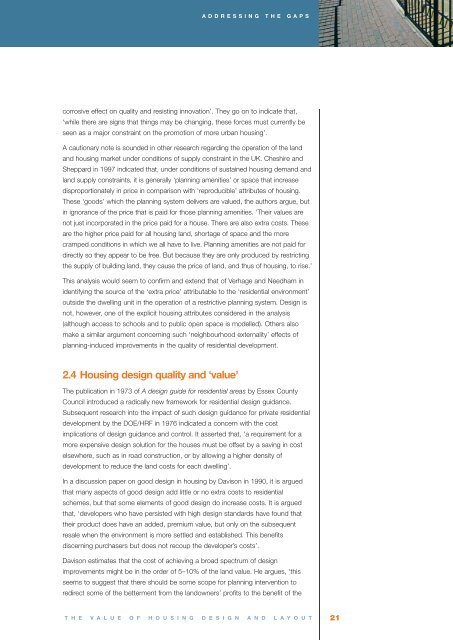The value of housing design and layout
The value of housing design and layout
The value of housing design and layout
Create successful ePaper yourself
Turn your PDF publications into a flip-book with our unique Google optimized e-Paper software.
corrosive effect on quality <strong>and</strong> resisting innovation’. <strong>The</strong>y go on to indicate that,<br />
‘while there are signs that things may be changing, these forces must currently be<br />
seen as a major constraint on the promotion <strong>of</strong> more urban <strong>housing</strong>’.<br />
A cautionary note is sounded in other research regarding the operation <strong>of</strong> the l<strong>and</strong><br />
<strong>and</strong> <strong>housing</strong> market under conditions <strong>of</strong> supply constraint in the UK. Cheshire <strong>and</strong><br />
Sheppard in 1997 indicated that, under conditions <strong>of</strong> sustained <strong>housing</strong> dem<strong>and</strong> <strong>and</strong><br />
l<strong>and</strong> supply constraints, it is generally ‘planning amenities’ or space that increase<br />
disproportionately in price in comparison with ‘reproducible’ attributes <strong>of</strong> <strong>housing</strong>.<br />
<strong>The</strong>se ‘goods’ which the planning system delivers are <strong>value</strong>d, the authors argue, but<br />
in ignorance <strong>of</strong> the price that is paid for those planning amenities. ‘<strong>The</strong>ir <strong>value</strong>s are<br />
not just incorporated in the price paid for a house. <strong>The</strong>re are also extra costs. <strong>The</strong>se<br />
are the higher price paid for all <strong>housing</strong> l<strong>and</strong>, shortage <strong>of</strong> space <strong>and</strong> the more<br />
cramped conditions in which we all have to live. Planning amenities are not paid for<br />
directly so they appear to be free. But because they are only produced by restricting<br />
the supply <strong>of</strong> building l<strong>and</strong>, they cause the price <strong>of</strong> l<strong>and</strong>, <strong>and</strong> thus <strong>of</strong> <strong>housing</strong>, to rise.’<br />
This analysis would seem to confirm <strong>and</strong> extend that <strong>of</strong> Verhage <strong>and</strong> Needham in<br />
identifying the source <strong>of</strong> the ‘extra price’ attributable to the ‘residential environment’<br />
outside the dwelling unit in the operation <strong>of</strong> a restrictive planning system. Design is<br />
not, however, one <strong>of</strong> the explicit <strong>housing</strong> attributes considered in the analysis<br />
(although access to schools <strong>and</strong> to public open space is modelled). Others also<br />
make a similar argument concerning such ‘neighbourhood externality’ effects <strong>of</strong><br />
planning-induced improvements in the quality <strong>of</strong> residential development.<br />
2.4 Housing <strong>design</strong> quality <strong>and</strong> ‘<strong>value</strong>’<br />
ADDRESSING THE GAPS<br />
<strong>The</strong> publication in 1973 <strong>of</strong> A <strong>design</strong> guide for residential areas by Essex County<br />
Council introduced a radically new framework for residential <strong>design</strong> guidance.<br />
Subsequent research into the impact <strong>of</strong> such <strong>design</strong> guidance for private residential<br />
development by the DOE/HRF in 1976 indicated a concern with the cost<br />
implications <strong>of</strong> <strong>design</strong> guidance <strong>and</strong> control. It asserted that, ‘a requirement for a<br />
more expensive <strong>design</strong> solution for the houses must be <strong>of</strong>fset by a saving in cost<br />
elsewhere, such as in road construction, or by allowing a higher density <strong>of</strong><br />
development to reduce the l<strong>and</strong> costs for each dwelling’.<br />
In a discussion paper on good <strong>design</strong> in <strong>housing</strong> by Davison in 1990, it is argued<br />
that many aspects <strong>of</strong> good <strong>design</strong> add little or no extra costs to residential<br />
schemes, but that some elements <strong>of</strong> good <strong>design</strong> do increase costs. It is argued<br />
that, ‘developers who have persisted with high <strong>design</strong> st<strong>and</strong>ards have found that<br />
their product does have an added, premium <strong>value</strong>, but only on the subsequent<br />
resale when the environment is more settled <strong>and</strong> established. This benefits<br />
discerning purchasers but does not recoup the developer’s costs’.<br />
Davison estimates that the cost <strong>of</strong> achieving a broad spectrum <strong>of</strong> <strong>design</strong><br />
improvements might be in the order <strong>of</strong> 5–10% <strong>of</strong> the l<strong>and</strong> <strong>value</strong>. He argues, ‘this<br />
seems to suggest that there should be some scope for planning intervention to<br />
redirect some <strong>of</strong> the betterment from the l<strong>and</strong>owners’ pr<strong>of</strong>its to the benefit <strong>of</strong> the<br />
T H E V A L U E O F H O U S I N G D E S I G N A N D L A Y O U T<br />
21

















